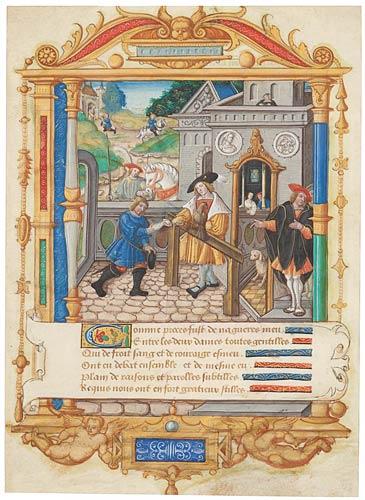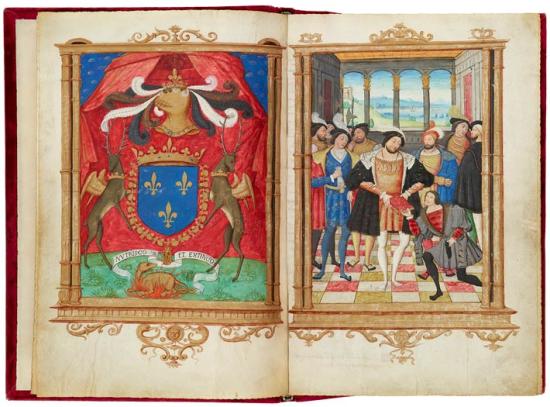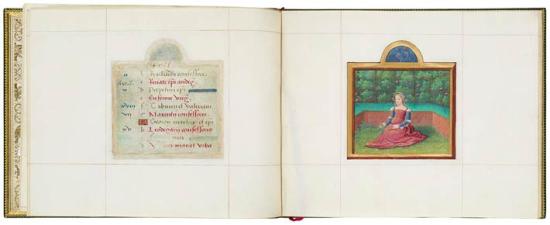Dawn of the Renaissance

Single leaf from Guillaume Crétin, Debate on Hunting with Dogs and Birds, in French
Illuminated by the Master of François de Rohan
Purchased with a grant from the B.H. Breslauer Foundation, 2011
Hunting with Dogs Versus Birds
This miniature comes from the unique illuminated copy of Crétin's poem on hunting with dogs versus birds. Handing his decision to a messenger is the count of Tancarville, who was asked to settle the debate (dogs win). The nobleman wears a gown with a wide fur collar and slit sleeves hanging by his sides. Through these slits he extends the sleeves of his doublet, which, in the Italian fashion, are tight on the forearm but puffed at the biceps. His shoes are square-toed. The courtier to the right wears a black mantle and slashed square-toed shoes. Both he and the count wear new low-brimmed hats.
Dawn of the Renaissance
After the coronation of François I in 1515, a fundamental change came about in French art and culture. The king, known even during his lifetime as "father of the arts," was a connoisseur who imported major Italian artists (Leonardo da Vinci among the first) and artworks to France on a grand scale. Italian fashions, which began to appear during the reign of his predecessor, Louis XII, flowered under François.
For men, the long bulky gowns of the previous period disappeared, replaced by short ones with wide shoulders. Worn open and with short sleeves, the new gown showed off the slashed front and sleeves of Italianate doublets that offered sexy glimpses of the man's linen shirts. Low-brimmed hats, worn at jaunty angles, were decorated with slanted ostrich feathers. Shoes were square-toed, their uppers sometimes slashed.
Women, too, adopted Italian styles. Their gowns, featuring low, square necks, provided glimpses of their linen smocks. Sleeves also displayed the smock: these were now often worn loosely tied to the bodice or split into two parts and slit along the underside.
King François I Sports the New Look

Romance of the Rose, in French
Illuminated by the Master of Girard Acarie
Gift of Beatrice Bishop Berle in memory of her father, Cortlandt Field Bishop, 1972
The 107 miniatures in this Roman de la rose owned by King François I comprise a veritable French Renaissance edition of Vogue. At the center of the frontispiece François receives the Roman from the scribe. He and his court are all dressed in the new Italianate style. Doublets, in rich fabrics, are often slashed on the chest and arms. The calf-length gowns have wide collars but short, puffy sleeves. Shoes are square-toed. Hats, low and wide, are worn at a jaunty angle and with slanting feathers. Indicative of his lower status, the scribe's gown, with its hanging slit sleeves, is a tad out of date.
Dawn of the Renaissance
After the coronation of François I in 1515, a fundamental change came about in French art and culture. The king, known even during his lifetime as "father of the arts," was a connoisseur who imported major Italian artists (Leonardo da Vinci among the first) and artworks to France on a grand scale. Italian fashions, which began to appear during the reign of his predecessor, Louis XII, flowered under François.
For men, the long bulky gowns of the previous period disappeared, replaced by short ones with wide shoulders. Worn open and with short sleeves, the new gown showed off the slashed front and sleeves of Italianate doublets that offered sexy glimpses of the man's linen shirts. Low-brimmed hats, worn at jaunty angles, were decorated with slanted ostrich feathers. Shoes were square-toed, their uppers sometimes slashed.
Women, too, adopted Italian styles. Their gowns, featuring low, square necks, provided glimpses of their linen smocks. Sleeves also displayed the smock: these were now often worn loosely tied to the bodice or split into two parts and slit along the underside.
Young Love in the Spring (Part 2)

Album of Calendar Miniatures
Illuminated by the Master of Claude de France
Purchased as the gift of the Virginia M. Schirrmeister Charitable Lead Trust, Mrs. Alexandre P. Rosenberg, Gifford Combs, James H. Marrow, Melvin R. Seiden, Salle Vaughn, and Sotheby's, and on the E. Clark Stillman Fund, in memory of Charles Ryskamp, 2010
Seated in a rose garden, a girl weaves a flower garland for her suitor. She is the illustration for the month of May from a prayer book, the calendar illustrations of which were excised during the nineteenth century and inserted into this album. The maiden is dressed in the new Italianate fashion. Her gown is cut with a low, square neck revealing the top of her linen smock. Her sleeves are in two parts, tied together and to the gown with gold laces. The linen of her smock pokes through at her shoulders, elbows, and the slits of the lower sleeve.
Dawn of the Renaissance
After the coronation of François I in 1515, a fundamental change came about in French art and culture. The king, known even during his lifetime as "father of the arts," was a connoisseur who imported major Italian artists (Leonardo da Vinci among the first) and artworks to France on a grand scale. Italian fashions, which began to appear during the reign of his predecessor, Louis XII, flowered under François.
For men, the long bulky gowns of the previous period disappeared, replaced by short ones with wide shoulders. Worn open and with short sleeves, the new gown showed off the slashed front and sleeves of Italianate doublets that offered sexy glimpses of the man's linen shirts. Low-brimmed hats, worn at jaunty angles, were decorated with slanted ostrich feathers. Shoes were square-toed, their uppers sometimes slashed.
Women, too, adopted Italian styles. Their gowns, featuring low, square necks, provided glimpses of their linen smocks. Sleeves also displayed the smock: these were now often worn loosely tied to the bodice or split into two parts and slit along the underside.